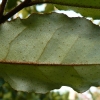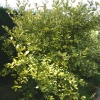Features
Glossy leaves, yellow from the centre with a narrow, irregular dark green margin and silvered underneath with slight brown spotting. The small, tubular, fragrant flowers are creamy-white and the fruits are red/brown.
What to use it for
Useful for providing a bit of brightness to a dark area in a border, as a hedge or trained as a wall shrub.
The foliage is popular for flower arranging.
How to look after it
A low maintenance plant which is relatively drought tolerant.
How to prune it
Prune out any shoots which have reverted to plain green.
If used as a hedge, cut it back each year in late summer. Cut shoots back to a healthy bud with secateurs (using hedge trimmers or shears will cut through leaves, damaging them and making the plant unsightly).
It can be renovated by hard pruning back into the old wood.
How to propagate it
Cuttings from the pungens species of elaeagnus can be difficult to root. Nodal semi-ripe cuttings can be taken in late summer to autumn, selecting material with large, bright shiny leaves. Take cuttings 7 to 10cm long with 2 to 3 nodes and remove all except the top 2 leaves, then wound the bottom 2cm of the stem and apply bottom heat of 15-20˚C to speed up rooting. Alternatively take hardwood cuttings from late autumn to late winter, choosing the most vigorous growth you can find for the cutting. Keep the cuttings in a frost-free, humid environment.
You can also propagate from seed, although the seed may not come true to type. Collect and sow the seeds as they ripen in spring. They may germinate immediately or wait until after the following winter’s cold.
Common problems
Elaeagnus sucker and coral spot.
Other useful information
Received the Royal Horticultural Society ‘Award of Garden Merit‘.







